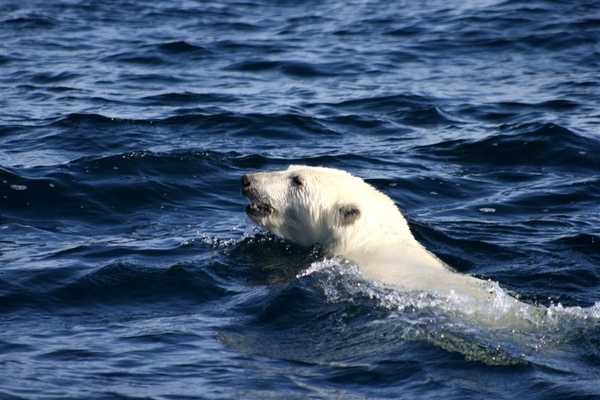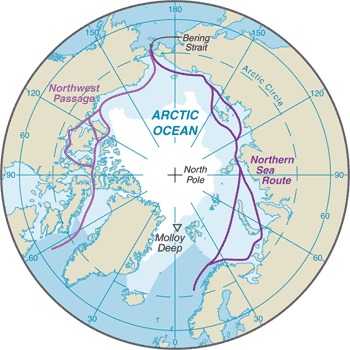Introduction
Background
The Arctic Ocean is the smallest of the world's five ocean basins (after the Pacific Ocean, Atlantic Ocean, Indian Ocean, and the Southern Ocean). The Northwest Passage (US and Canada) and Northern Sea Route (Norway and Russia) are two important seasonal waterways. In recent years, the polar ice pack has receded in the summer allowing for increased navigation and raising the possibility of future sovereignty and shipping disputes among the Arctic coastal states affected (Canada, Denmark (Greenland), Iceland, Norway, Russia, US).
Visit the Definitions and Notes page to view a description of each topic.
Geography
Location
body of water between Europe, Asia, and North America, mostly north of the Arctic Circle
Geographic coordinates
90 00 N, 0 00 E
Map references
Arctic Region
Area
total : 15.558 million sq km
note: includes Barents Sea, Beaufort Sea, Chukchi Sea, East Siberian Sea, Greenland Sea, Kara Sea, Laptev Sea, Northwest Passage, Norwegian Sea, and other tributary water bodies
Area - comparative
slightly less than 1.5 times the size of the US
Coastline
45,389 km
Climate
polar climate characterized by persistent cold and relatively narrow annual temperature range; winters characterized by continuous darkness, cold and stable weather conditions, and clear skies; summers characterized by continuous daylight, damp and foggy weather, and weak cyclones with rain or snow
Ocean volume
ocean volume: 18.75 million cu km
percent of World Ocean total volume: 1.4%
Major ocean currents
two major, slow-moving, wind-driven currents (drift streams) dominate: a clockwise drift pattern in the Beaufort Gyre in the western part of the Arctic Ocean and a nearly straight line Transpolar Drift Stream that moves eastward across the ocean from the New Siberian Islands (Russia) to the Fram Strait (between Greenland and Svalbard); sea ice that lies close to the center of the gyre can complete a 360 degree circle in about 2 years, while ice on the gyre periphery will complete the same circle in about 7-8 years; sea ice in the Transpolar Drift crosses the ocean in about 3 years
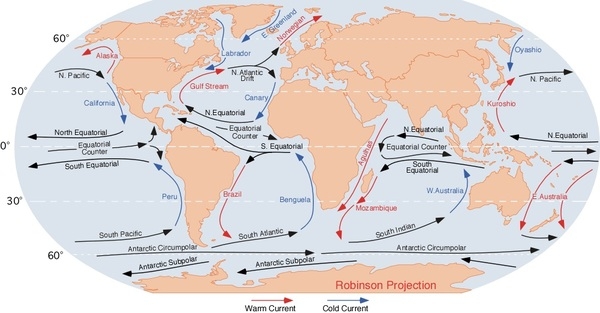
Bathymetry
continental shelf: The continental shelf (see Figure 1), a rather flat area of the sea floor adjacent to the coast that gradually slopes down from the shore to water depths that are typically less than 200 m (660 ft). Dimensions can vary: they may be narrow or nearly nonexistent in some places or extend for hundreds of miles in others. The waters above the continental shelf are usually productive in both plant and animal life, both from sunlight and nutrients from ocean upwelling and terrestrial runoff. More than one quarter of the Arctic sea floor is continental shelf. The Eurasian shelf is very wide, extending out 1,500 km (930 mi), and is the largest continental shelf in the world. The following are examples of features found on the continental shelf of the Arctic Ocean (see Figure 2).
Barents Shelf
Beaufort Shelf
Davis Sill
Chukchi Shelf
East Siberian Shelf
Kara Shelf
Laptev Shelf
Lincoln Shelf
continental slope: The continental slope (see Figure 1) is where the ocean bottom drops off more rapidly until it meets the deep-sea floor (abyssal plain) at depths exceeding 3,000 m (9,850 ft). The deep waters of the continental slope are characterized by cold temperatures, low light conditions, and very high pressures. Sunlight does not penetrate to these depths, having been absorbed or reflected in the water above. The continental slope can be indented by submarine canyons, often associated with the outflow of major rivers. Another feature of the continental slope is alluvial fans, or cones of sediments, that major rivers carry downstream to the ocean and deposit down the slope. The following are examples of features found on the continental slope of the Arctic Ocean (see Figure 2):
Litke Trough
Novaya Zemlya Trough
Svyataya Anna Trough (Saint Anna Trough)
Voronin Trough
abyssal plains: The abyssal plains (see Figure 1), at depths of over 3,000 m (10,000 ft) and covering 70% of the ocean floor, are the largest habitat on earth. Sunlight does not penetrate to the sea floor, making these deep, dark ecosystems less productive than those along the continental shelf. Despite their name, these “plains” are not uniformly flat; they are interrupted by features like hills, valleys, and seamounts. The following are examples of features found on the abyssal plains of the Arctic Ocean (see Figure 2):
Baffin Basin
Canada Basin
Fram/Amundsen Basin
Greenland Abyssal Plain
Iceland Basin
Makarov Basin
Molloy Deep; note - deepest point in the Arctic Ocean
Nansen Basin
Norwegian Basin
mid-ocean ridge: The mid-ocean ridge (see Figure 1) that rises from the abyssal plain is an underwater mountain range over 64,000 km (40,000 mi) long, reaching an average depth of 2,400 m (8,000 ft). Mid-ocean ridges form at divergent plate boundaries where two tectonic plates are moving apart and magma pushing up from the mantle creates new crust. Tracing their way around the global ocean, this system of underwater volcanoes forms the longest mountain range on Earth. Fracture zones are linear transform faults that develop perpendicular to the line of the mid-ocean ridge, which can offset the ridge line and divide it into segments. The following are examples of mid-ocean ridges found in the Arctic Ocean (see Figure 2):
Gakkel Ridge
Mohns Ridge
undersea terrain features:
The Abyssal Plain is commonly interrupted by a variety of undersea terrain features including seamounts, guyots, ridges, and plateaus.
Seamounts (see Figure 1) are submarine mountains at least 1,000 m (3,300 ft) high that are formed from individual volcanoes on the ocean floor. They are distinct from the plate-boundary volcanic system of the mid-ocean ridges because seamounts tend to be circular or conical. A circular-collapse caldera is often centered at the summit, evidence of a magma chamber within the volcano. "Hot spots" in the deep mantle often feed long chains of seamounts. These hot spots are associated with stationary plumes of molten rock rising from deep within the Earth's mantle. The hot-spot plumes melt through the overlying tectonic plate as it moves and supplies magma to the active volcanic island at the end of the chain of volcanic islands and seamounts.
Flat-topped seamounts are known as guyots.
An undersea ridge is an elongated elevation of varying complexity and size, generally having steep sides.
An undersea plateau is a large, relatively flat elevation that is higher than the surrounding relief, with one or more relatively steep sides. Although submerged, these features can reach close to sea level.
The following are examples of undersea terrain features found on the floor of the Arctic Ocean (see Figure 2):
Lomonosov Ridge
Gakkel Ridge
Alpha Ridge
Mendeleev Rise
Chukchi Plateau
ocean trenches: there are no oceanic trenches on the Arctic sea floor
atolls: there are no atolls found in the Arctic Ocean
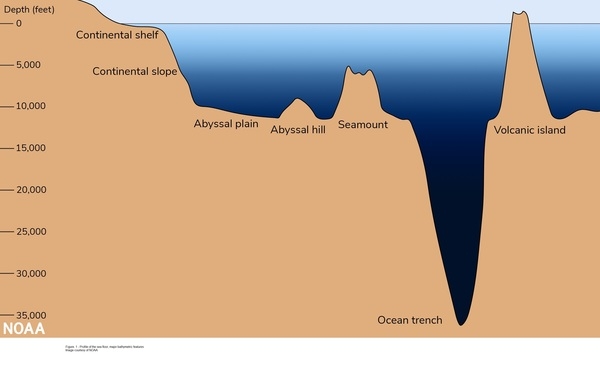
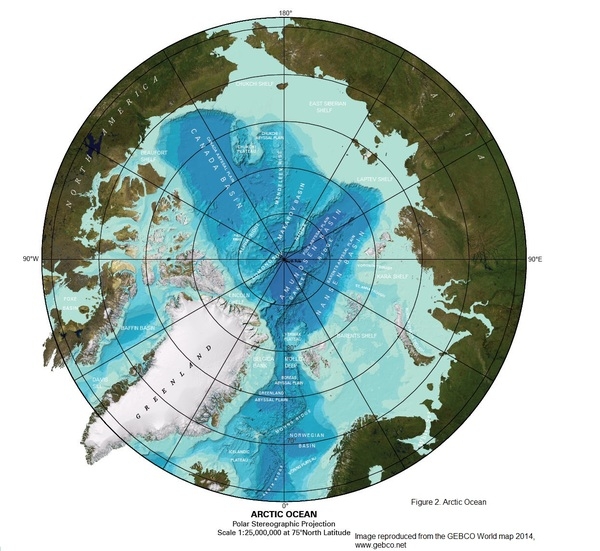
Elevation
highest point: sea level
lowest point: Molloy Deep -5,577 m
mean depth: -1,205 m
ocean zones: Composed of water and in a fluid state, the ocean is delimited differently than the solid continents. It is divided into three zones based on depth and light level. Sunlight entering the water may travel about 1,000 m into the oceans under the right conditions, but there is rarely any significant light beyond 200 m.
The upper 200 m (656 ft) of the ocean is called the euphotic, or "sunlight," zone. This zone contains the vast majority of commercial fisheries and is home to many protected marine mammals and sea turtles. Only a small amount of light penetrates beyond this depth.
The zone between 200 m (656 ft) and 1,000 m (3,280 ft) is usually referred to as the "twilight" zone, but is officially the dysphotic zone. In this zone, the intensity of light rapidly dissipates as depth increases. Such a minuscule amount of light penetrates beyond a depth of 200 m that photosynthesis is no longer possible.
The aphotic, or "midnight," zone exists in depths below 1,000 m (3,280 ft). Sunlight does not penetrate to these depths, and the zone is bathed in darkness.
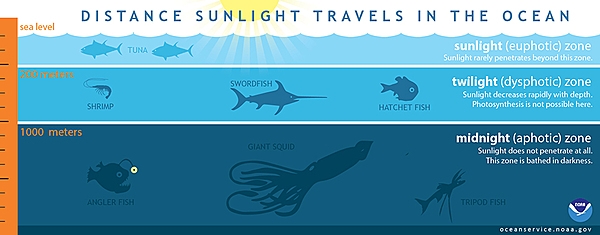
Natural resources
sand and gravel aggregates, placer deposits, polymetallic nodules, oil and gas fields, fish, marine mammals (seals and whales)
Natural hazards
ice islands occasionally break away from northern Ellesmere Island; icebergs calved from glaciers in western Greenland and extreme northeastern Canada; permafrost in islands; virtually ice locked from October to June; ships subject to superstructure icing from October to May
Geography - note
major chokepoint is the southern Chukchi Sea (northern access to the Pacific Ocean via the Bering Strait); strategic location between North America and Russia; shortest marine link between the extremes of eastern and western Russia; floating research stations operated by the US and Russia; maximum snow cover in March or April about 20 to 50 centimeters over the frozen ocean; snow cover lasts about 10 months
Environment
Environment - current issues
climate change; changes in biodiversity; water pollution from use of toxic chemicals; endangered marine species include walruses and whales; fragile ecosystem slow to change and slow to recover from disruptions or damage; thinning polar icepack
Climate
polar climate characterized by persistent cold and relatively narrow annual temperature range; winters characterized by continuous darkness, cold and stable weather conditions, and clear skies; summers characterized by continuous daylight, damp and foggy weather, and weak cyclones with rain or snow
Marine fisheries
the Arctic fishery region (Region 18) is the smallest in the world with a catch of only 708 mt in 2019, although the Food and Agriculture Organization assesses that some Arctic catches are reported in adjacent regions; Russia and Canada were historically the major producers; in 2017, Canada, Denmark (Greenland), Iceland, Norway, Russia, and the US, along with the People’s Republic of China, the European Union, Japan, and the Republic of Korea, agreed to a 16-year ban on fishing in the Central Arctic Ocean to allow for time to study the ecological system of these waters
Regional fisheries bodies: International Council for the Exploration of the Seas; Agreement to Prevent Unregulated High Seas Fisheries in the Central Arctic Ocean
Government
Country name
etymology: the name Arctic comes from the Greek word arktikos meaning "near the bear" or "northern," and that word derives from arktos, meaning "bear"; the name refers either to the constellation Ursa Major, the "Great Bear," which is prominent in the northern celestial sphere, or to the constellation Ursa Minor, the "Little Bear," which contains Polaris, the North (Pole) Star
Transportation
Transportation - note
sparse network of air, ocean, river, and land routes; the Northwest Passage (North America) and Northern Sea Route (Eurasia) are important seasonal waterways
Transnational Issues
Disputes - international
note: record levels of summer melting of sea ice in the Arctic has renewed interest in maritime shipping lanes and sea floor exploration
